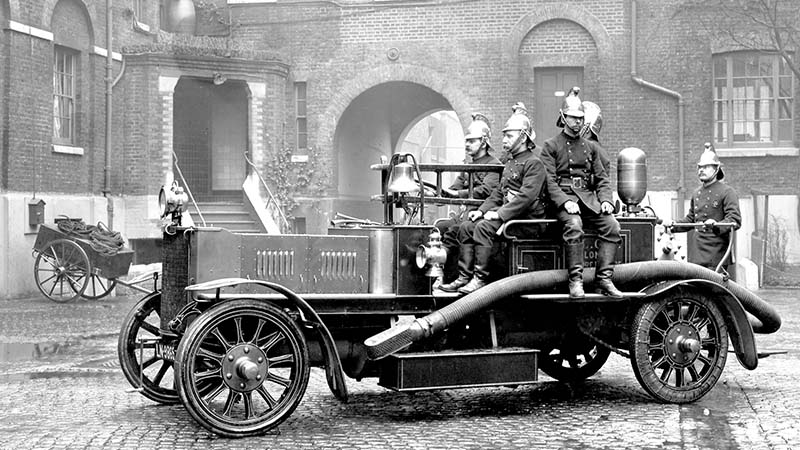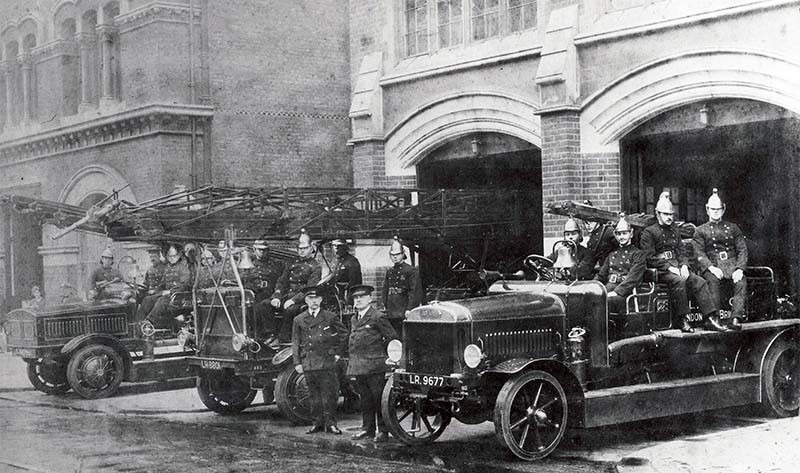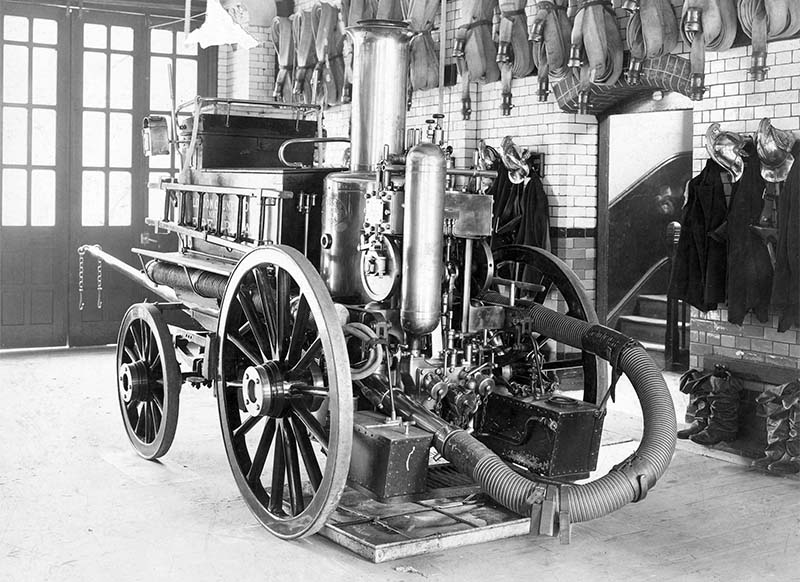The First World War began in July 1914, and in June 1917 Germany launched the first ever major air offensive which brought the war to the doorsteps of Londoners. In response, London Fire Brigade swiftly developed strategies to combat the effects of aerial bombardment which laid the foundations for fighting fires in the next war and beyond.
At the start of the First World War, many of London's firefighters (known then as firemen) responded to calls to enlist in the Army or Royal Navy. Around 280 had been reservists, and because the Brigade had a tradition of recruiting men from the Navy, many went back to sea. This placed a huge strain on the Brigade. It had to deal with normal firefighting duties, as well as the results of bombing and fallout from thousands of anti-aircraft shells fired at enemy aircraft.

| Date | Authorised number of firefighters |
Actual number of firefighters |
Shortfall |
| August 1914 | 1369 | 1369 | 0 |
| December 1914 | 1251 | 851 | 400 |
| December 1915 | 1580 | 1280 | 300 |
| December 1916 | 1296 | 1066 | 224 |
When firefighters enlisted into the Army and Navy it created a massive shortfall of firefighters available in London. Initially the Brigade tried to solve this problem internally but soon had to look elsewhere for assistance. This led to other organisations working together to fill these roles. This included the military, Local Volunteer Reserves (LVR) and works brigades. For example the Kodak Factory had its own motorised fire engines. The LVR’s 1917 recruitment pamphlet, 'Enrol to Fight Both Fire & Foe' gave equal weight to its firefighting and military roles. In November 1918 the London County Council (LCC) thanked 250 members of the LVR for their war-work.
The London Salvage Corps were also used to fight fires. Their peacetime role was to save property but in May 1915, it was placed at the disposal of London Fire Brigade. During air raids they used their horse drawn salvage tenders equipped with basic firefighting equipment to fight fires locally.
In June 1917, more than 200 people were killed following the devastating bombing of the area around St Paul's Cathedral. After a great deal of high-level discussion, it was decided in July to recall London's firefighters that were serving in the military. This reintroduced a group of experienced firefighters but it still wasn’t enough.
On 25 September 1917, the government ordered that a special fire brigade area should be established. This covered 750 square miles and brought together 90 local authority fire brigades. This included London Fire Brigade, and was known as the Metropolitan Fire Brigade Area (MFBA). The Brigade's Chief Officer would be in charge. The MFBA area covered the City of London, the Metropolitan Police District and the urban districts of Watford, Dartford and Egham.
When air raids were imminent all fire brigades were to come under the direction of a Mobilising Officer. The Mobilising Officer made sure reinforcements were sent to assist firefighting operations. The scheme started in October 1917.

The movement of fire appliance vehicles took place in two phases. Both phases required motorised fire appliances to be brought in from external brigades to stand by at designated London fire stations. Horse-drawn fire appliances were not used, as they were less efficient and slower to deploy. In the ‘First Move’ eleven motorised fire appliances from eleven brigades would be sent to designated London fire stations. They would swap places with less efficient appliances such as motor escapes vans. These were sent from London to cover the home stations. When necessary the ‘Second Move’ was authorised, using motorised fire appliances from fourteen brigades.
During the war it was necessary to operate the First Move mobilisation nineteen times and the Second Move twice. Initially the scheme was limited to air raids, but extended later to cover fires at military installations and munitions factories within the MFBA.
The lack of firefighters in the First World War was also reflected in support roles. On 28 January 1915 Chief Officer Lieutenant-Commander Sampson Sladen, RN, authorised hiring women as “substitutes”. They would fill roles left vacant by men on war service. Their roles would involve clerical work and semi-skilled work in the Brigade's workshops.
This laid the foundation for the important service women were to contribute in the Second World War as part of the Auxiliary Fire Service and later the National Fire Service.
Even before the war began, London Fire Brigade understood that the days of horse drawn fire appliances were numbered. However, at the start of the First World War there were still many horse drawn fire appliances in the brigade. As the war progressed horses and horse feed were in very short supply, as were qualified coachmen to drive these appliances.
This prompted the LFB to sell off their remaining horse drawn appliances. By the end of the war, the Brigade was fully mechanised save for a few horse drawn escapes.

During air raids it was clear that the impressive brass helmets worn by firefighters did not give adequate protection from shrapnel. On 5 February 1918 a special maintenance grant for £900 (the equivalent of £72,606 today) was given for the purchase of 2000 shrapnel-proof steel helmets to replace them.

When outside brigades assisted the LFB at major fires it was evident that there was a disparity with certain pieces of equipment. In particular this was an issue with hose couplings which would not fit other brigade’s hoses. The LFB set aside £2,785 (£224,675 today) from its 1918-1919 budget to purchase extra hose and couplings. This included a universal adaptor which allowed incompatible hose couplings used by external brigades to couple to London hose. This encouraged a drive to standardise equipment universally.
The significant increase in callouts in London due to the First World War alerted LFB to the problem of water supply. By 1919 the Brigade possessed an impressive 77 miles of modern rubber-lined hose to help solve the problem which persisted into the Second World War.
The First World War left an indelible impact not only on London but on British fire brigades nationally, touching every aspect of the fire service. There is no doubt that London Fire Brigade was the driving force behind the creation of this often unsung legacy.
This article was researched and written by museum volunteer Mick F.